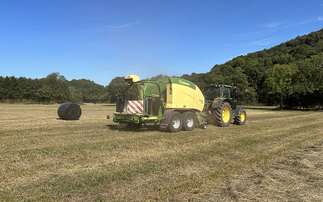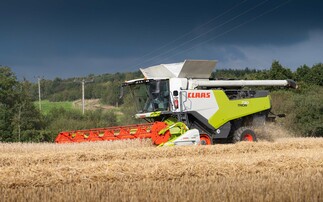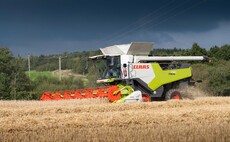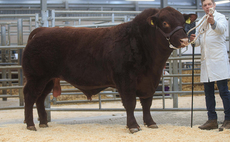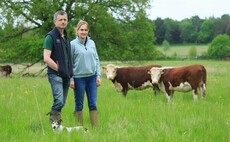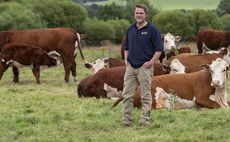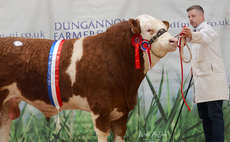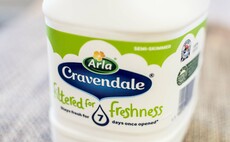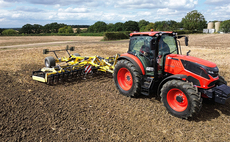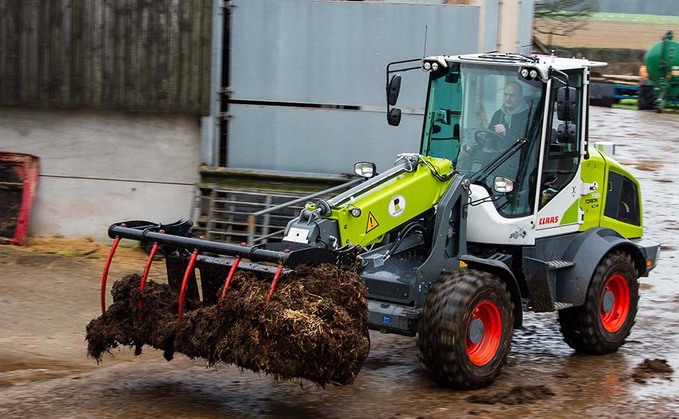
Representing one of the firm's latest loader developments, we try out Claas' new pivot steer telehandler, the Torion 738 T Sinus. James Rickard puts the machine to work to find out more.
The Torion 738 T Sinus is the first pivot steer loader model from Claas UK to feature a telescoping boom. In addition, it also features a clever party piece in the form of rear wheel steering, adding to its articulation steering action. In doing so, the manufacturer has created, quite literally, a more flexible machine than it previously offered in this lift capacity bracket, with more reach and more manoeuvrability.
For those that may not remember, Claas did a deal with fellow German firm Liebherr, giving Claas access to a large portfolio of loaders, now sold in the UK in the familiar green and white livery of the ag-manufacturer. With this came a line-up of side-boom telehandlers, Scorpions, and a range wheeled loaders, Torions.
Our test subject, the Torion 738 T Sinus, is from the family of small Torions. This new machine effectively combines the tried and tested rear-end of the 644 model, with a newly developed front-end featuring a telescoping boom, hence the ‘T' in the model number. Similarly, ‘Sinus' denotes the use of a rear steering axle.
To put it into context, the 738 T Sinus, with its 2.3 tonne lift capacity and its near five metre lift, is roughly equivalent to a JCB TM220 or a Weidemann 4080T, for example. But can it compete? To find out more about the machine, we put it through the mill on a variety of handling tasks, from mucking out pens to handling bales.
Hydraulics and handling
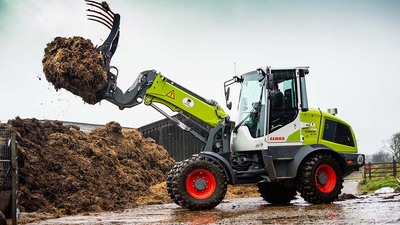
The 738's 93 litre/minute hydraulic pump capacity affords relatively swift loader actions, for this size of machine. You certainly do not need to rev this machine hard to make it work. And if more pump capacity is required, there is a 115 litre/minute option.
Via the joystick, you have really good proportional control over the hydraulics. To help this, the machine also features a few driver aids whereby you can set the upper and lower limits of the boom and the crowd limit of the headstock. This can be set through the screen and is useful for repetitive work, such as loading grain into a trailer. Once set-up, you can then turn on/off the bits of the system you want to use, using rocker switches - you may only want an upper limit, for example.
Likewise, boom suspension can also be turned on or off, or set to automatic, with further adjustment made through the screen. Flow rates to the third and fourth services and crowd and tilt actions can all be adjusted through the screen, also.
As with many loaders these days, the 738 does feature a depressurisation system for the third and fourth services, making it easier to attach/detach oil pipes.
However, unlike other systems, which often only require the quick press of a button to depressurise the lines, this system is a bit of a faff. In this instance you have turn the machine off, key on electrical power, press and hold a button and then ‘wiggle' the third or fourth service. While it is a relatively small inconvenience, it can add up to a big frustration when swapping attachments several times a day. It definitely needs simplifying.
On a similar note, the machine also requires you to tell it what attachment has been selected, every time you swap an attachment. Again, it is not a massive hardship to do, but just one of those little bugbears. We are told that this is going to be made an automatic process in the future.
Up front, the machine only comes with one type of headstock, which is a good headstock, but a pin and cone option, at least, would be good for this segment. For extra flexibility, the manufacturer is also looking into a pickup hitch.
Manoeuvrability and stability
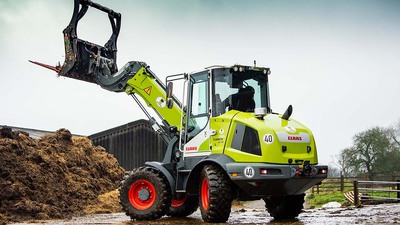
Giving the 738 T that all important tight turning circle is an articulation joint which can pivot 30 degrees and rear axle steering which can provide a lock of 25 degrees. In all, this adds up to a very tight turning circle with a 4,225mm radius to the outside of the machine, turning tighter than some smaller models in the manufacturer's range.
Compared to a traditional pivot steer machine, it does feel a little different when driving, but you quickly get used to it. And because the machine does not have to rely only on articulated steering, it means the machine can stay that little bit straighter more of the time, increasing stability.
The rear axle's steering is effectively controlled by rods which are linked to the front of the machine, giving proportional movement between the articulation point of the loader and the rear steering. The loader also oscillates/twists in the middle, much like a JCB TM, which often splits opinion among operators, with some favouring loaders which just use a swinging rear axle instead, like a Schaffer. This said, with its seven tonne operating weight, the machine does feel well planted.
For safety, the machine features the manufacturer's Dynamic Load Stabilisation (DLS) system. Compared to some systems which just ‘lock you out' as soon as you hit the limits of the handler, this system is a lot more passive and will gradually slow the hydraulic movements down, the nearer you get to the limits.
It is certainly a lot less interfering compared to some systems, and if you do hit the limit, in most cases all you have to do is bring the load back closer to you. But if that is not enough, you can always use the ‘parachute' button, or in this case, ‘a crane hook button' to override the system.
In addition, rather than use strain gauges on the rear axle, the DLS system uses load sensors in the main and secondary lift rams and takes into account steering and boom angles. It is also self-calibrating.
Engine and transmission
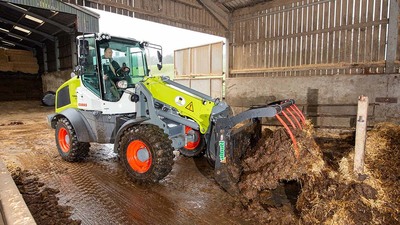
Though the 738 only has 73hp, it is plenty enough to power the hydraulics and, in combination with the transmission and the machine's weight, provides a decent amount of pushing force, too. It is very much intended to be a handler and not a climber.
Propelling the machine up to 40kph is an automatic twin-speed hydrostatic transmission. For high tractive power at slow speeds, up to 19kph, two hydro-motors are engaged. Above 19kph, one motor disengages, to improve efficiency.
During operation, though there are no actual ranges changes being made, it does sort of sound like this, as one motor disengages/re-engages. It is plenty smooth enough to use, and you can limit the machine's top speed by selecting low range, preventing it from disengaging a motor.
In addition, when in low range, the full range of the ‘travel' pedal then represents 0-19kph, effectively desensitising the pedal and making it easier to drive at slow speeds. Further enabling precise handling requirements are combined inching/brake pedals, one for each foot. This said, you rarely need the brakes with a hydro machine, but the inching function does come in useful to bleed off a bit of transmission oil, enabling a few more revs to be used to speed up loader actions.
On top of the range changes, you can also limit the top speed by using a dial, which is really useful if using the machine with a dispenser or yard brush. And if a little extra traction is required, the front axle features a fully lockable diff, activated by a button on the joystick.
The transmission will also nearly hold itself on a hill when you come to a stop, even in neutral. Handbrake activation is manual, via rocker switch, which would be really good if it was automated, as many loaders are these days.
Cab and controls
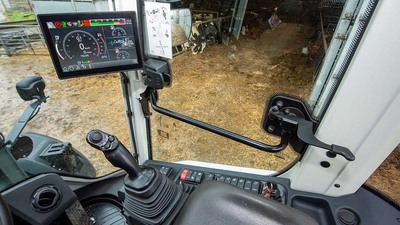
Up top is a generously-sized cab, especially for this size of machine. The only downside is that it may be a little bit too tall for some traditional or older-type farm buildings. This said, it is a great place to work and feels like a cab off a ‘big' machine.
It is easy to access, too, with plenty of grab handles and a good straight line into the cab, unlike some which require a bit of twisting to get in and out of.
Inside the cab, controls are well laid out, with grouping of functions making operation easier. Confusingly though, the switch to change transmission ranges is mounted in the roof lining, not on the main console, which is where you would assume it would be.
For main loader control, the joystick, which moves with the seat, also incorporates a mini thumb-operated joystick/pad. This set-up allows you to carry out multiple actions at once, making the most of your fingers and thumbs.
Rather than a traditional dash in front of the steering wheel, the 738 and all of its other Stage 5 Torion siblings feature a corner post-mounted nine inch touch screen terminal. From here, all vital machine information is displayed and it is where all machine adjustments can be made. Thanks to a bright and bold layout, the screen is fairly simple to navigate and get things set-up.
To get in a comfy driving position, the cab features a harvester style steering column, with three piece adjustment. Like a combine or a forager, you can pretty much put the steering wheel where you want it.
Visibility all round is good. The four post cab design helps a lot with this, as does the high driving position, which sees you look down over the top of the boom, rather than staring at the back of it like some machines.
Practicalities
Hyd level
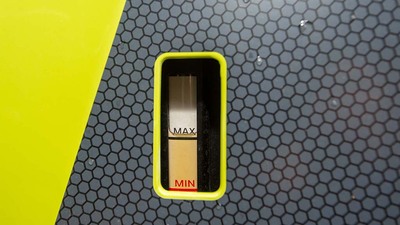
Hydraulic level is easy to see, thanks to a cut out in the bonnet
Diesel cap
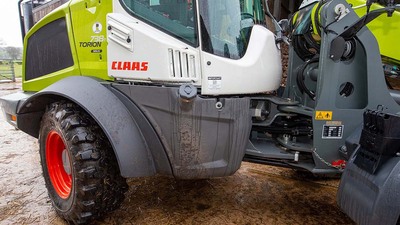
Diesel cap is easily accessible and not positioned under the bonnet like some
Couplings
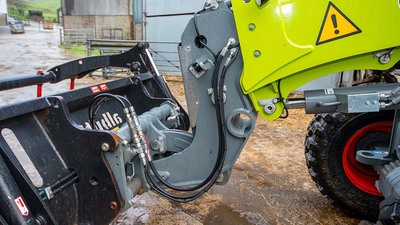
For convenience, hydraulic couplings are mounted on the headstock
Z-linkage
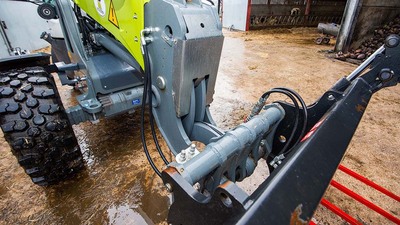
Z-linkage in the neck provides a high amount of headstock rotation
Verdict
During our time with the machine, the Torion 738 T Sinus definitely proved itself as a capable performer at a variety of tasks.
Hydraulic performance is good, with enough power to get the job done. And as for its rear steered axle party piece, it really does enable it to weave in and out of tight spaces. In addition, the cab is a great place to work, with plenty of precise control afforded by the ‘stick and pedals.
As with all machines, there are a couple of areas that could be improved; simplified depressurisation and attachment recognition systems would be much appreciated.
Overall, while it is up against some tough competition, the 738 T is well worth considering.










